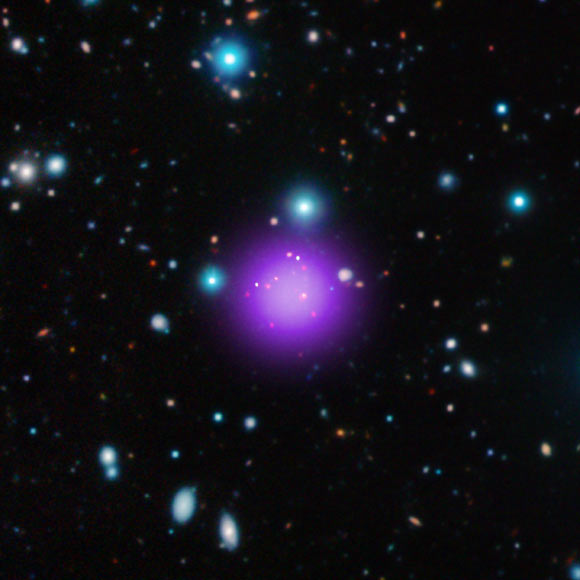Using five space- and four ground-based telescopes, an international team of astronomers has found the most distant galaxy cluster to date.

This composite image shows the young galaxy cluster CL J1001 in X-rays from Chandra (purple), infrared data from ESO’s UltraVISTA survey (red, green, and blue), and radio waves from the Atacama Large Millimeter/submillimeter Array (green). Image credit: X-ray – NASA / CXC / CEA / T. Wang et al; infrared – ESO / UltraVISTA; radio – ESO / NAOJ / NRAO / ALMA.
The galaxy cluster, called CL J1001+0220 (CL J1001 for short), lies about 11.1 billion light years from Earth.
The discovery of this remote object pushes back the formation time of galaxy clusters – the largest structures in the Universe held together by gravity – by about 700 million years.
“This galaxy cluster isn’t just remarkable for its distance, it’s also going through an amazing growth spurt unlike any we’ve ever seen,” said Dr. Tao Wang of Nanjing University and the French Alternative Energies and Atomic Energy Commission (CEA), lead author on the Astrophysical Journal paper (arXiv.org preprint) announcing the discovery.
CL J1001 was found in data from the Cosmic Evolution Survey (COSMOS), a project that observes the same patch of sky in many different kinds of light ranging from radio waves to X-rays.
The discovery was made using a large group of space- and ground-based observatories including NASA’s Chandra, Hubble and Spitzer space telescopes, ESA’s XMM-Newton and Herschel space observatories, the NSF’s Karl G. Jansky Very Large Array, the Atacama Large Millimeter/submillimeter Array, the IRAM NOEMA, and ESO’s Very Large Telescope.
In addition to its extraordinary distance, CL J1001 is remarkable because of its high levels of star formation in galaxies near the center of the cluster.
Within about 250,000 light years of its core, eleven massive galaxies are found and nine of those display high rates of star formation.
Specifically, stars are forming in the cluster core at a rate equivalent to about 3,400 Sun-mass stars per year.
The diffuse X-ray emission detected by NASA’s Chandra and ESA’s XMM-Newton Observatory comes from a large amount of hot gas, one of the defining features of a true galaxy cluster.
The large amount of growth through star formation in CL J1001’s galaxies distinguishes it from other galaxy clusters found at distances of about 10 billion light years and closer, where little growth is occurring. These results suggest that elliptical galaxies in clusters may form their stars through more violent and shorter bursts of star formation than elliptical galaxies outside clusters.
According to the authors, CL 1001 may be undergoing a transformation from a galaxy cluster that is still forming, known as a ‘protocluster,’ to a mature one. Scientists have never found a galaxy cluster at this precise stage.
“It appears that we have captured this galaxy cluster at a critical stage just as it has shifted from a loose collection of galaxies into a young, but fully formed galaxy cluster,” said study co-author Dr. David Elbaz, also from CEA.
Also, this discovery suggests that much of the star formation in these galaxies happens after the galaxies fall onto the cluster, not before.
In comparing their results to computer simulations of the formation of clusters performed by other scientists, the astronomers found that CL J1001 has an unexpectedly high amount of mass in stars compared to the cluster’s total mass.
This may show that the build-up of stars is more rapid in distant clusters than simulations imply, or it may show that clusters like CL J1001 are so rare that they are not found in today’s largest cosmological simulations.
_____
Tao Wang et al. 2016. Discovery of a galaxy cluster with a violently starbursting core at z=2.506. ApJ 828, 56; doi: 10.3847/0004-637X/828/1/56







